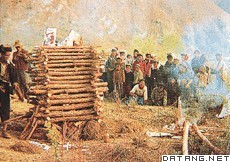1) crematory incinerator


火葬炉
2) cremation
[英][krə'meɪʃn] [美][krə'meʃən]


火葬
1.
Expound the origins and evolution of cremation of qing dynasty;


论清代火葬制度的渊源及演变
2.
Since 1956,China has launched the interment feform from the traditional burial to cremation.
1956年4月,我国开始了从传统土葬到火葬的殡葬变革。
4) crematory
[英]['kremətəri] [美]['krimə,torɪ]


火葬场
1.
Three flue gas samples covering 9 corpses were collected from a crematory in China and measured for the concentrations of PCDDs and PCDFs.
对中国某火葬场9具遗体进行了二英类污染物排放测试,测试结果表明,烟气中二英类物质总浓度为89~350ng·m-3,毒性当量浓度为1。
5) convention of cremation


火葬习俗
1.
Though the convention of cremation had declined in Ming Dynasty a nd from the court there’s a detailed ban on it,some humble dead still had be en cremated.
火葬习俗在明代已趋衰落,朝廷也有具体禁令,但一些身份低微的亡者仍有人以火葬之法处置。
6) cremation gravestones


火葬墓碑
1.
Recently cremation gravestones have been discovered in Baoshan,dated from Dali Kingdom down to Yuan Dynasty.
近年来,保山市发现了南诏、大理国到元代时期火葬墓碑,墓碑内容证明,阿吒力教在保山市曾有过辉煌的历史,并影响了保山市的历史文化以及今天的民俗。
补充资料:火葬
| 火葬 cremation 传统葬式。以火焚尸,将骨灰贮于盒(坛、缸、瓮等)内的殡葬方式。始于欧洲新石器时代。中国最早流行火葬的是春秋战国时的氐羌人,其后藏、彝、拉祜、纳西、普米、怒、哈尼、傣等族在历史上也行火葬。部分地区仍保持此种习俗。藏族只有活佛、上层喇嘛和贵族行火葬。现代,世界各国大中城市的居民死后大都实行火葬。
因民族和地区不同,火葬仪式和方法也不尽一致。彝族火葬时,凶死者骨灰扬弃,正常死亡者骨灰用土稍加掩盖。拉祜族将死者及其生前使用的用具一起火化。普米族则用四方形棺将尸体抬到火葬场 ,把尸体置于放有蜂 蜜和酥油的“柴房”中火化,后将骨灰送往高山的骨灰洞中。火葬在欧洲、亚洲的其他地区也有悠久历史。古希腊和罗马人为战争中死去的英雄举行隆重的火葬典仪。印度的佛教徒和印度教徒死后必火葬,将骨灰撒于恒河中。 |
说明:补充资料仅用于学习参考,请勿用于其它任何用途。
参考词条
